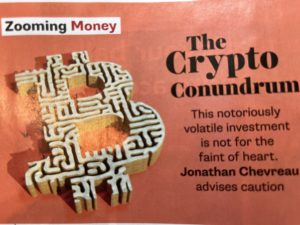 Zoomer Magazine has just published a column by me on investing in cryptocurrencies. Contained in the June/July 2022 issue, the headline is The Crypto Conundrum.
Zoomer Magazine has just published a column by me on investing in cryptocurrencies. Contained in the June/July 2022 issue, the headline is The Crypto Conundrum.
There is an online version but it is not yet available: when it is, I will update with a clickable link. Alternatively, you can subscribe to the print edition and/or the digital edition, by clicking here.
As the adjacent artwork shows, “this notoriously volatile investment is not for the faint of heart” and I therefore “advise caution.”
As Murphy’s Law would have it, between the time the article was written and edited, crypto crashed, with Bitcoin plunging below US$30,000. In fact, this weekend was a brutal correction for crypto in general: see this Reuters report on Bitcoin touching an 18-month low of US$23,476 over the weekend.
The article does of course stress the volatility of this asset class and it goes without saying that if you’re a long-term believer in crypto — a so-called HODLer (for Hold On for Dear Life) — then you’re much better off investing in Bitcoin closer to $30,000 than the near $60,000 it reached late in 2021.
The article arose when a Zoomer editor was intrigued by a MoneySense column I wrote early in 2021 about my own personal experience with investing in Cryptos. You can find it by clicking on this highlighted headline: How to invest in Cryptocurrencies(without losing your shirt.
The gist of both articles is that I suggest investors restrict themselves initially to just Bitcoin and Ethereum, which I regard as the “Big 2” of crypto. I also suggest using ETFs in registered portfolios, and taking profits if and when they materialize: by selling half on any double, you can do what Mad Money’s Jim Cramer calls “playing with the house’s money.”
The other guideline I offer is to restrict total crypto investments to 1 or 2% of your total wealth: a range recommended by billionaires like Paul Tudor Jones or Stanley Druckenmiller.
Start small and try to play with the house’s money as soon as you can
The article notes that as reported here, as of January 2022, Fidelity has 2% in its balanced and 3% in its more aggressive asset allocation ETFs. FBAL has 59% stocks, 39% bonds, and 2% crypto while its growthier FGRO is 82% stocks, 15% bonds and 3% crypto. These seem to me prudent allocations for investors wanting a sliver of crypto. Continue Reading…





